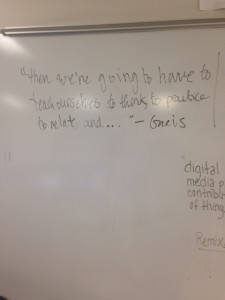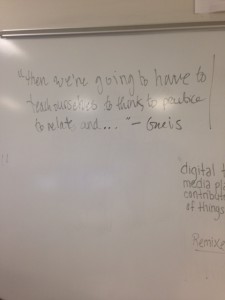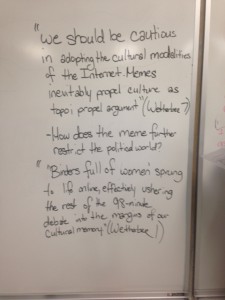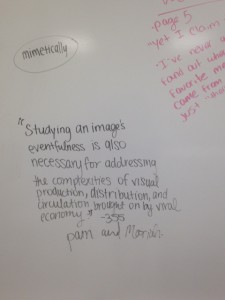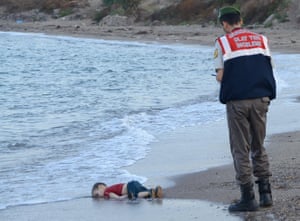*Everyone should find one excerpt, type it out, and provide analysis of the excerpt chosen. If you were trying to make a larger argument, you would need to go in and find textual evidence of it. DO NOT QUOTE & SUMMARIZE but quote & find evidence to support the claim in one or two sentences.
Kairos- a notion of opportunity (the time being right).
Domesticate- to tame that is suitable for a particular space (in context to Greis’ article)
Associative- linked to or tied to
Contiguous- next to each other
Irreverent- not respectful
Key Claims of Articles
Picking Up the Fragments of the 2012 Election: Memes, Topoi, and Political Rhetoric
- Social media is becoming too involved in politics, specifically memes that are taking us away from the heart of the issues or core of politics.
- “Some memes function as a rhetorical topoi” (Wetherbee 2).
- “The internet memes are fleeting bits of discourse that quickly lose steam…”, in other words, memes don’t necessarily last once they go away from what once gave them momentum; they go away (Wetherbee 3).
- Memes have an impact and a sort of power. As they circulate, they are changing.
- The meme “binders full of women” took off because it tapped into other things that was circulating about how people felt about Romney
- Memes are distancing from its social context
Iconographic Tracking: A Digital Research Method for Visual Rhetoric and Circulation Studies
- Images are not stable
- Circulation is beyond what users of the internet can control
*Continue discussion on the blog by analyzing quotes found in the article
Presentations
Ashley: What’s So Special About a Meme?
- The Willy Wonka meme uses the same photo but provide different contexts and is essentially farther from the original context
Samantha: The Art of the Meme
- There may be a consequence of an image as it circulates
- Memes are in the political scene and are used to send political messages or may be a spoof on the real message the candidate is trying to convey
Jodiann: The Virality of Memes
- How memes go viral
- She believes memes are an accidental invention
- Memes are popular in culture
- Memes changes our ways of knowing and understanding, the way we think and interact with each other
Pamela: Got Milk? Got Meme?
- How an advertising campaign can turn into a meme
- Promotion of milk in the United States turned into a meme
- Participatory culture where memes allow us to do so
- Memes can be taken in different ways





